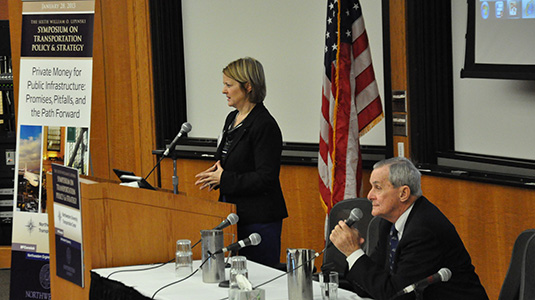Hundreds Gather for Public-Private Partnership Discussion at Lipinski Symposium
Sixth Lipinski Symposium hosted by the Northwestern University Transportation Center

A once-impressive railway system now ranked 18th in the world. An air transportation system ranked 30th in the world. Congested parts unable to accomodate today's large megaships.
“Our infrastructure is crumbling as we speak,” former Illinois Rep. Jerry F. Costello told a packed audience January 28 at the sixth William O. Lipinski Symposium on Transportation Policy & Strategy, citing a recent study by the advocacy group Building America’s Future. “We truly do have a crisis on our hands, and we cannot wait any longer to address our needs.”
With public funding dwindling, one way to face this crisis is through public-private partnerships, Costello said — arrangements that offer financial incentives for private investment in public infrastructure and for sharing cost, revenue, and performance risks between business and government. But challenges must be addressed before public-private partnerships, also known as P3’s, are a fully effective option, he noted.
Hundreds of elected officials, business leaders, transit advocates, and students gathered at this year’s Lipinski Symposium, “Private Money for Public Infrastructure: Promises, Pitfalls, and the Path Forward.” The event — named for former Rep. William O. Lipinski of Chicago, who hosted the conference — was organized by the Northwestern University Transportation Center at the James L. Allen Center, 2169 Campus Drive, in Evanston.
Sessions delved into the workings of public-private partnerships. In a session on case studies, leaders shared their experiences bringing to fruition three different and successful public-private partnerships: the Denver Regional Transportation District’s Eagle P3 commuter rail line to Denver International Airport; the monetization of the Chicago Skyway and Indiana Toll Road; and the East End Crossing of the Louisville-Southern Indiana Ohio River Bridges Project. Later in the afternoon, panelists discussed challenges and opportunities of P3’s, including navigating complex bureaucracies, keeping projects transparent, and winning public opinion when many Americans remain skeptical of the agreements.
Samara Barend, vice president & strategic development director of public-private partnerships and alternative delivery for AECOM, emphasized that P3’s are not funding sources but financing arrangements that normally attract private money to initiate large public projects with the expectation of earning a reasonable financial return over the long run.
Representing the investment banking sector, Thomas Lanctot, partner and group head of William Blair & Company, said it’s vital to make P3’s attractive to private investors by keeping transaction terms fair for both partners; keeping transaction sizes large enough to warrant the expensive bid process; and minimizing political risk. Political risk is a “huge problem,” Lanctot said, adding that he has seen projects fall through at the last minute, after the private investor has spent large amounts of time and money, because of political decisions to pull back from the arrangement.
“P3’s are not free. There’s no P3 fairy or P3 money tree,” he noted. “The private sector is looking to make a return on its investment.”
During lunch, the David F. Schulz Award for achievements in transportation infrastructure policy was awarded to Chicago Transit Authority President Forrest Claypool, whose leadership has led to an aggressive program to bring CTA infrastructure to a state of good repair. The award is named for the late Dave Schulz, the founding director of Northwestern’s Infrastructure Technology Institute.
Other speakers at the symposium included:
- Randy Blankenhorn, executive director, Chicago Metropolitan Agency for Planning
- Greg Ciambrone, vice president, The Walsh Group-East End Crossing of the Louisville-Southern Indiana Ohio River Bridges Project
- Richard Clarke, assistant general manager of capital programs, Denver Regional Transportation District-Eagle P3 Project
- Rep. Daniel Lipinski, 3rd district of Illinois
- Hani Mahmassani, director, Transportation Center, Northwestern University
- Adrian Moore, vice president of policy, Reason Foundation
- Fernando Redondo, chief executive officer, Chicago Skyway
- Matt Rose, chief executive officer, BNSF Railway Company
- Ann Schneider, secretary, Illinois Department of Transportation
- Joseph L. Schofer, director, Infrastructure Technology Institute, and professor and associate dean, McCormick School of Engineering and Applied Science
- Peter Skosey, vice president, Metropolitan Planning Council (Chicago)